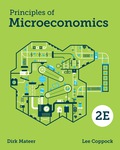
EBK PRINCIPLES OF MICROECONOMICS (SECON
2nd Edition
ISBN: 9780393616149
Author: Mateer
Publisher: W.W.NORTON+CO. (CC)
expand_more
expand_more
format_list_bulleted
Question
Chapter 10, Problem 9SP
To determine
Identify the impact of price effect and output effect on an increase in the bus service charge.
Expert Solution & Answer
Want to see the full answer?
Check out a sample textbook solution
Students have asked these similar questions
Not use ai please
Active Learning 4: Computing GDP
Cookies
2021
(base year)
2022
2023
P
Q
P
Q
P
Q
$1 900
$2 1,000
$3
1,250
200 $1,200
210
Smartphones $900 185 $1,000
Use the above data to solve these problems:
A. Compute nominal GDP in 2021.
B. Compute real GDP in 2022.
C. Compute the GDP deflator in 2023.
Mankiw, Principles of Macroeconomics, 10th Edition. 2024 Cengage. All Rights Reserved. May not be scanned, copied or duplicated, or posted to a publicly accessible website, in whole or in part.
34
=4
Don't used hand raiting and don't used Ai solution
Chapter 10 Solutions
EBK PRINCIPLES OF MICROECONOMICS (SECON
Knowledge Booster
Similar questions
- check my answers and draw the graph for me.arrow_forwardThe first question, the drop down options are: the US, Canada, and Mexico The second question, the drop down options are: the US, Canada, and Mexico The last two questions are explained in the photo.arrow_forwardcheck my answers, fix them if they are wrong. everything is in the picture. the drop down menus are either kansas or Illinois, except the last one which is yes or no.arrow_forward
- everything is in the imagearrow_forwardeverything is in the image!arrow_forwardRespond to isaiah Great day everyone and welcome to week 6! Every time we start to have fun, the government ruins it! The success of your business due to the strong economy explains why my spouse feels excited. The increase in interest rates may lead to a decline in new home demand. When mortgage rates rise they lead to higher costs which can discourage potential buyers and reduce demand in the housing market. The government increases interest rates as a measure to suppress inflation and stop the economy from growing too fast. Business expansion during this period presents significant risks. Before making significant investments it would be prudent to monitor how the market responds to the rate increase. Business expansion during a decline in demand for new homes could create financial difficulties.arrow_forward
arrow_back_ios
SEE MORE QUESTIONS
arrow_forward_ios
Recommended textbooks for you
 Microeconomics: Private and Public Choice (MindTa...EconomicsISBN:9781305506893Author:James D. Gwartney, Richard L. Stroup, Russell S. Sobel, David A. MacphersonPublisher:Cengage Learning
Microeconomics: Private and Public Choice (MindTa...EconomicsISBN:9781305506893Author:James D. Gwartney, Richard L. Stroup, Russell S. Sobel, David A. MacphersonPublisher:Cengage Learning Economics: Private and Public Choice (MindTap Cou...EconomicsISBN:9781305506725Author:James D. Gwartney, Richard L. Stroup, Russell S. Sobel, David A. MacphersonPublisher:Cengage Learning
Economics: Private and Public Choice (MindTap Cou...EconomicsISBN:9781305506725Author:James D. Gwartney, Richard L. Stroup, Russell S. Sobel, David A. MacphersonPublisher:Cengage Learning
 Microeconomics: Principles & PolicyEconomicsISBN:9781337794992Author:William J. Baumol, Alan S. Blinder, John L. SolowPublisher:Cengage Learning
Microeconomics: Principles & PolicyEconomicsISBN:9781337794992Author:William J. Baumol, Alan S. Blinder, John L. SolowPublisher:Cengage Learning Economics (MindTap Course List)EconomicsISBN:9781337617383Author:Roger A. ArnoldPublisher:Cengage Learning
Economics (MindTap Course List)EconomicsISBN:9781337617383Author:Roger A. ArnoldPublisher:Cengage Learning

Microeconomics: Private and Public Choice (MindTa...
Economics
ISBN:9781305506893
Author:James D. Gwartney, Richard L. Stroup, Russell S. Sobel, David A. Macpherson
Publisher:Cengage Learning

Economics: Private and Public Choice (MindTap Cou...
Economics
ISBN:9781305506725
Author:James D. Gwartney, Richard L. Stroup, Russell S. Sobel, David A. Macpherson
Publisher:Cengage Learning


Microeconomics: Principles & Policy
Economics
ISBN:9781337794992
Author:William J. Baumol, Alan S. Blinder, John L. Solow
Publisher:Cengage Learning

Economics (MindTap Course List)
Economics
ISBN:9781337617383
Author:Roger A. Arnold
Publisher:Cengage Learning
